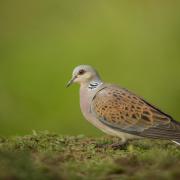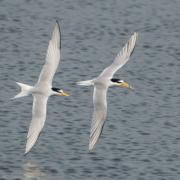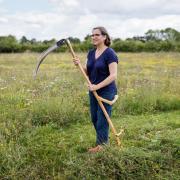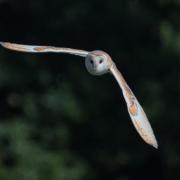Our rivers are vital for sustaining all life but they need our help. On the iconic River Waveney, volunteers are coming to the rescue
Messing about on the Waveney over this past year on our motorboat ‘Bittern’, we realised how much we have grown to love this river. Wide open stretches, swishing reeds, and birds soaring overhead in a vast sky, there’s a sense of freedom that's hard to find elsewhere.
Sadly that’s not the full story because all is not well with our rivers. There’s a whole team of River Waveney Trust volunteers focused on the enormous challenges of achieving and maintaining a healthy ecosystem in the face of formidable environmental changes. Keen to learn more, I decided to pay a visit to Martha Meek, development manager of the RWT. Her zeal for rivers immediately shines through.

“Rivers are a natural wildlife corridor, not only the water but the habitat either side as well,” she says. “They are the artery that runs through the countryside connecting towns and villages. Not only have they got wildlife and conservation benefits, they’ve also got really strong community, heritage and history.” Martha explains how volunteers in three groups in the RWT are working diligently at specific sites to maintain riverbank spaces, restore habitats, and tackle invasive species as well as educating and engaging with communities. The largest is the Frenze Bank nature reserve near Diss where volunteers tackled local wetland overgrown with willow scrub and neglected pathways to turn the site into a haven for wildlife and visitors.

As the RWT celebrates its 10th anniversary, it now has some 50 volunteers and three paid staff members, including Martha, a huge step-up from being a purely voluntary body a couple of years ago. Sitting at her large kitchen table, she wastes no time in running smartly through the key issues that blight the future of our rivers, not just the Waveney. The first thing to note is that the Waveney has been altered hugely over the years, as all rivers have, to suit the various interests, from farming and milling to navigation and tourism.
“They have been straightened, deepened and widened and often there’s an artificially straight deep channel and not much diversity in there,” says Martha. “And because the Waveney is quite a slow-flowing river, in the summer we get problems with low dissolved oxygen levels compounded by the amount of fertilisers and nutrients that are coming off farmland into the water.”
READ: Best places for watersport in Suffolk
Run-off from agriculture and raw sewage outfalls are not only a Waveney problem. The EU Water Framework Directive, which has been retained by the UK, shows that every one of our rivers failed on chemical status in the last round of monitoring in 2019. It would be easy to lose hope but that is not the attitude of the RWT. So what’s to be done?


Tree planting might sound like a mild reaction to such formidable hurdles but it plays a key part in the health of the river and it’s one of the many tasks of the RWT volunteers. “In the summer there’s not a lot of shade on the water and you’ve got these high nutrient levels and not much flow of water,” Martha explains. “You can have so little oxygen in the water that you can actually end up with fish dying. Obviously that affects other animals in the water as well.”
As with all things on the river, partnerships are the key to success. I have a list of 16 including the Broads Authority, RSPB and the Water Management Alliance. “And there’s more,” says Martha. “The first thing I did when I started in this job was to ring round all the organisations just to find out how we could complement each other. For example, we’ve been working closely with the Environment Agency to see where we can keep fallen trees in the river, cut or pinned back, rather than removing them. This increases the diversity in the channel to benefit wildlife which can actually have an effect on the food chain.
“And you can imagine otters in the tree roots, nesting birds, and different plants as well, so you can end up with silt accumulating which creates shallower bits of water, because what we’ve lost on the Waveney are gently shelving sections for those deeply rooted aquatic plants which are so fantastic for wildlife."


This joined-up approach is a big step forward, says Martha. "To have that communication between ourselves and the flood risk team. New interpretation boards on the portage points will tell people about why we’re leaving wood in the channel and about not disturbing wildlife and not disturbing other river users. We’re trying to facilitate a better relationship between anglers, canoeists and other river users.” A Love Your River Day in Bungay on July 2 will explain 'why we love wood in our rivers'.
Stewardship is high on the RWT agenda and canoe survey volunteers are working hard on the Paddle Access and Biodiversity project from Shotford Bridge down to Geldeston Lock, funded by Defra and Essex and Suffolk Water. “We have volunteers trained to use a specially designed app and they are going out to survey the river every two months,” says Martha. "They look at a specific section of the river for any issues with pollution or anything they need to report back on.”

As part of the Water Friendly Farming project, Martha’s colleague, catchment project officer Emily Winter, has installed a silt trap so that polluted water collecting in a field corner at the bottom of a hill does not run straight off into the river. Emily is also working with a cluster of 19 farms to improve water quality and to protect and enhance woodlands throughout the Waveney catchment, funded by the Farming in Protected Landscapes programme.
“Probably the most important thing farmers can do would be to reduce the amount of fertilisers and nutrients that are coming off their land into the water,” says Martha. “Regenerative agriculture is looking at a more holistic way of farming and reducing pesticides and fertilisers so it is happening.”
So what is the main message in this 10th anniversary year? Martha’s message is an urgent one for water-stressed East Anglia. “We need to treat water as a precious resource, not just as a problem especially during a high rainfall when we try to channel it away as quickly as we can off the land to the bottom of the catchment. Making rivers bigger, wider or straighter is not the answer to more intense rainfall events. We need to think about water recycling and taking care of water a lot more. What we need to do is to slow it up higher in the catchment.”
She also points out that sewage is getting into our rivers because there’s a right for homes and businesses to connect clean rainfall downpipes into sewage treatment works, meaning they become overwhelmed. “We need to think about separating clean and dirty water, and using nature-based solutions such as reed beds to treat effluent, taking that clean water away from our sewage treatment works and actually capturing it and using it.” Martha refers me to ‘Reclaim the Rain’ a joint Suffolk and Norfolk County Council initiative looking at how we can value water as a resource and also natural flood management at the same time.
“We need to look at how we can manage rivers so that they yield multiple benefits, including for wildlife. There’s a real misunderstanding that if you dredged a river, it would flood less, and that’s simply not true because the river can’t take those volumes of water. What we need to do is to slow it up higher in the catchment. If everyone understood that message it would be a lot easier for us to engage with people and carry out those restoration projects.”
Find out more at riverwaveneytrust.org



























